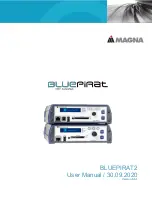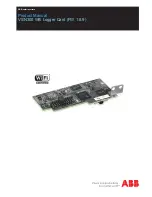
Section 4. Sensor Support
42
4.3.1
Measurements Requiring AC Excitation
Some resistive sensors require AC Excitation. These include electrolytic tilt
sensors, soil moisture blocks, water conductivity sensors, and wetness sensing
grids. The use of DC excitation in these sensors can result in polarization, which
will cause erroneous measurement, shift calibration, or lead to rapid sensor
decay.
Other sensors, e.g., LVDTs (Linear Variable Differential Transformer), require
and AC excitation because they rely on inductive coupling to provide a signal.
DC excitation will provide no output.
CR200(X) bridge measurements cannot reverse excitation polarity to provide
AC excitation and avoid ion polarization. Sensors requiring AC excitation
should not be used with the CR200(X).
Other Campbell Scientific dataloggers (e.g. CR800 series, CR1000, CR3000)
are compatible with sensors that require AC excitation.
4.4 Pulse Count Measurement
FIGURE. Switch Closure Pulse Sensor
p. 42 is a generalized schematic showing
connection of a pulse sensor to the CR200(X). The CR200(X) features two
dedicated pulse input channels, P_SW and P_LL, and two digital I/O channels,
C1and C2, for measuring pulse output sensors. Activated by the PulseCount ()
instruction, dedicated 16-bit counters on P_SW, P_LL, C1 and C2 are used to
accumulate all counts over the user specified scan interval. The value which is
output for each scan is the difference in the last known counter value and the
new counter value. Since the last count is maintained for each scan, even if the
counter rolls over between scans the correct count will be recorded. If the time
between scans is such that the counter exceeds 65,536 pulses during a scan, then
the counter will roll over twice resulting is an erroneous measurement.
PulseCount () instruction parameters specify the pulse input type, channel used,
and pulse output option.
Note: The PulseCount instruction must be executed once before the pulse or
control port is ready for input. This may be of particular concern for programs
with long scan intervals. For example, the PulseCount () instruction will not
yield a valid output until the turn of the second hour if the PulseCount ()
instruction is used within a program with a scan interval of 1 hour.
Figure 29: Switch Closure Pulse Sensor
Summary of Contents for CR200
Page 32: ...Section 2 Quickstart Tutorial 22 ...
Page 45: ...Section 3 Overview 35 3 3 Specifications ...
Page 46: ...Section 3 Overview 36 ...
Page 58: ...Section 4 Sensor Support 48 ...
Page 62: ...Section 5 Measurement and Control Peripherals 52 ...
Page 78: ...Section 8 CR200 X Configuration 68 ...
Page 102: ...Section 9 Programming 92 ...
Page 138: ...Section 11 Programming Resource Library 128 ...
Page 156: ...Section 16 Support Software 146 ...
Page 160: ...Section 17 Care and Maintenance 150 ...
Page 167: ...Section 18 Troubleshooting 157 18 3 3 2 Charging Circuit Test Solar Panel ...
Page 168: ...Section 18 Troubleshooting 158 18 3 3 3 Charging Circuit Test Transformer ...
Page 169: ...Section 18 Troubleshooting 159 18 3 3 4 Adjusting Charging Circuit Voltage ...
Page 170: ...Section 18 Troubleshooting 160 ...
Page 184: ...Appendix A Glossary 14 ...
Page 190: ...Appendix B Status Table and Settings 20 ...
Page 192: ...Appendix C Serial Port Pin Outs 22 ...
Page 211: ......
















































